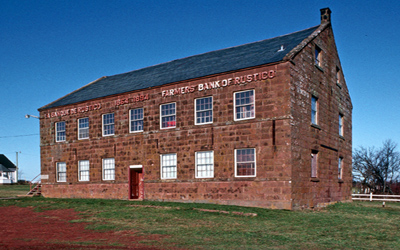Farmers' Bank of Rustico National Historic Site of Canada
South Rustico, Prince Edward Island

General view
© Parks Canada Agency / Agence Parcs Canada.
Address :
Church Street, South Rustico, Prince Edward Island
Recognition Statute:
Historic Sites and Monuments Act (R.S.C., 1985, c. H-4)
Designation Date:
1959-05-25
Dates:
-
1861 to 1863
(Construction)
Event, Person, Organization:
-
Georges-Antoine Belcourt, Reverend
(Person)
Other Name(s):
-
Farmers' Bank of Rustico
(Designation Name)
-
Farmers’ Bank of Rustico Museum
(Other Name)
Research Report Number:
1960-17, 1970-11, 1990-AM-01
Plaque(s)
Existing plaque: on the Bank Building Church Street, South Rustico, Prince Edward Island
Under the leadership of Rev. G.-A. Belcourt, a former pioneer missionary in the West, his parishioners erected this building to house one of the first people's banks in Canada. Chartered in 1864, and directed by farmers and fishermen, it continued to operate until 1894 and foreshadowed the development of the credit union movement. The bank, by providing cheap credit, enabled the people of this predominantly Acadian community to gain economic independence.
Description of Historic Place
Located in the small hamlet of Rustico on Prince Edward Island, the Farmers’ Bank of South Rustico National Historic Site of Canada is a modestly sized, ruggedly simple, stone building in the British classical tradition. Seven bays wide, with two-and-a-half storeys, the bank stands adjacent to a church and alongside a road to the water’s edge. The building is now operated as a museum. Official recognition refers to the interior and exterior of the building.
Heritage Value
The Farmers’ Bank of Rustico was designated a national historic site of Canada in 1959 because, under the leadership of the parish priest Georges Antoine Belcourt, this building was erected to house one of the first people’s banks in Canada.
The Farmers’ Bank of Rustico illustrates an important stage in the evolution of co-operative banking in the 19th century in Canada. Father G. A. Belcourt led the parishioners who constructed the bank building between 1861 and 1863. Chartered in 1864, and directed by farmers and fishermen, it operated until 1894, and heralded the development of the credit union movement. The bank provided cheap credit and small loans allowing members of this predominantly Acadian farming community to purchase lands, make improvements, and gain economic independence.
Sources: Historic Sites and Monuments Board of Canada, Minutes, May 1959; February 1970.
Character-Defining Elements
The key elements that contribute to the heritage character of this site include: the building’s location amongst a cluster of buildings near the church of St. Augustine; the rural setting surrounded by agricultural land; the regularly coursed sandstone construction; the solid, two-and-a-half-storey massing under a medium-pitch gable roof; the seven-bay façade with central entrance, and regularly placed windows; the multi-pane, sash windows; the square vault projecting from the west wall; the overall unadorned appearance, with minimal exterior details that include stringcourses, eaves set close to the walls, and windows without mouldings; surviving evidence of its original interior functional design and interior features, notably its wooden posts and small fireplaces.